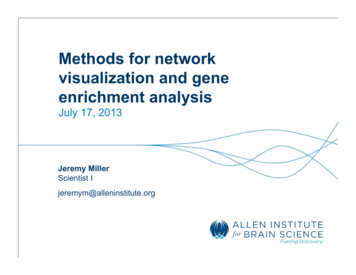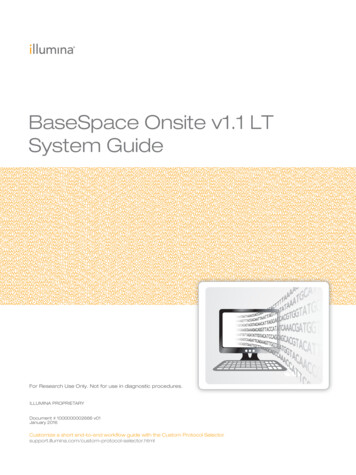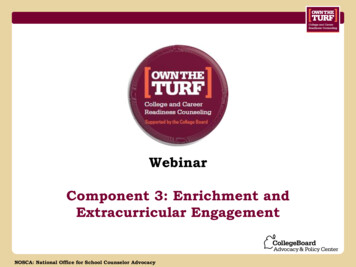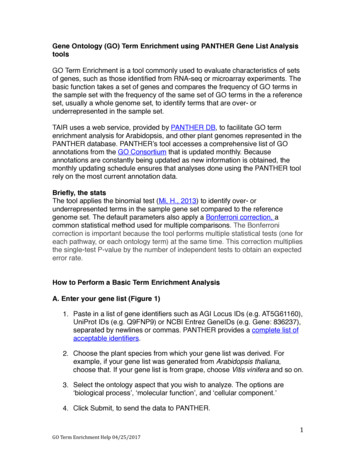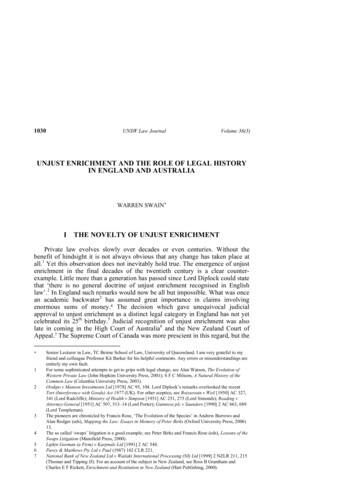
Transcription
1030UNSW Law JournalVolume 36(3)UNJUST ENRICHMENT AND THE ROLE OF LEGAL HISTORYIN ENGLAND AND AUSTRALIAWARREN SWAIN*ITHE NOVELTY OF UNJUST ENRICHMENTPrivate law evolves slowly over decades or even centuries. Without thebenefit of hindsight it is not always obvious that any change has taken place atall.1 Yet this observation does not inevitably hold true. The emergence of unjustenrichment in the final decades of the twentieth century is a clear counterexample. Little more than a generation has passed since Lord Diplock could statethat ‘there is no general doctrine of unjust enrichment recognised in Englishlaw’.2 In England such remarks would now be all but impossible. What was oncean academic backwater3 has assumed great importance in claims involvingenormous sums of money.4 The decision which gave unequivocal judicialapproval to unjust enrichment as a distinct legal category in England has not yetcelebrated its 25th birthday.5 Judicial recognition of unjust enrichment was alsolate in coming in the High Court of Australia6 and the New Zealand Court ofAppeal.7 The Supreme Court of Canada was more prescient in this regard, but the 1234567Senior Lecturer in Law, TC Beirne School of Law, University of Queensland. I am very grateful to myfriend and colleague Professor Kit Barker for his helpful comments. Any errors or misunderstandings areentirely my own fault.For some sophisticated attempts to get to grips with legal change, see Alan Watson, The Evolution ofWestern Private Law (John Hopkins University Press, 2001); S F C Milsom, A Natural History of theCommon Law (Columbia University Press, 2003).Orakpo v Manson Investments Ltd [1978] AC 95, 104. Lord Diplock’s remarks overlooked the recentTort (Interference with Goods) Act 1977 (UK). For other sceptics, see Boissevain v Weil [1950] AC 327,341 (Lord Radcliffe); Ministry of Health v Simpson [1951] AC 251, 275 (Lord Simonds); Reading vAttorney-General [1951] AC 507, 513–14 (Lord Porter); Guinness plc v Saunders [1990] 2 AC 663, 689(Lord Templeman).The pioneers are chronicled by Francis Rose, ‘The Evolution of the Species’ in Andrew Burrows andAlan Rodger (eds), Mapping the Law: Essays in Memory of Peter Birks (Oxford University Press, 2006)13.The so called ‘swaps’ litigation is a good example; see Peter Birks and Francis Rose (eds), Lessons of theSwaps Litigation (Mansfield Press, 2000).Lipkin Gorman (a Firm) v Karpnale Ltd [1991] 2 AC 548.Pavey & Matthews Pty Ltd v Paul (1987) 162 CLR 221.National Bank of New Zealand Ltd v Waitaki International Processing (NI) Ltd [1999] 2 NZLR 211, 215(Thomas and Tipping JJ). For an account of the subject in New Zealand, see Ross B Grantham andCharles E F Rickett, Enrichment and Restitution in New Zealand (Hart Publishing, 2000).
2013Thematic: Unjust Enrichment and the Role of Legal History1031law in that jurisdiction has veered off in a very different direction to the rest ofthe Commonwealth.8It is sometimes tempting to assume that if there was ever a legal categorywithout a history then unjust enrichment is it. Until recently its very existencewas questioned. Yet there is a paradox here. Despite the novelty of unjustenrichment, arguments based on historical sources have played a critical role.The contrast with contract and tort in this respect is striking.9 The reason for thisis not hard to find. In the battle for acceptance, history is thought by many to be apowerful weapon against the sceptics. In the past decade in Australia, mattershave taken a very different turn. Historical arguments have been utilised todiscredit unjust enrichment rather than to defend it. The merits of unjustenrichment should not be determined by history alone. An examination of thehistorical arguments is, in any event, unlikely to change the minds of sceptics orsupporters. Nevertheless, since history is so intertwined with the debate about theexistence of unjust enrichment, the past deserves to be properly understood. Bycoming to terms with the thread of history which runs through the case law andacademic commentary, it is possible to come to some broader conclusions aboutthe roles of judges and legal academics in the process of legal change.IIHISTORY AND THE BIRTH OF UNJUST ENRICHMENTA good case can be made for recognising James Barr Ames as the foundingfather of unjust enrichment in the United States.10 Ames is usually betterremembered as a legal historian and his expertise clearly influenced his views onunjust enrichment. In an article on the history of the action of assumpsit, Ameswent on to draw the broad conclusion that:8910Deglman v Guaranty Trust Co of Canada [1954] SCR 725. For a discussion of recent decades, seeMitchell McInnes, ‘Unjust Factors, Juristic Reasons and Contracts in Anglo-Canadian Law’ in PaulaGiliker (ed), Re-examining Contract and Unjust Enrichment: Anglo–Canadian Perspectives (MartinusNijhoff , 2007) 23, 34–48.There are of course examples of historical argument in contract and tort cases in both England andAustralia. The point is that historical arguments haven not shaped the modern law in such a fundamentalmanner. See, eg, Keith Stanton, ‘Use of Scholarship by the House of Lords in Tort Cases’ in James Lee(ed), From House of Lords to Supreme Court: Judges, Jurists and the Process of Judging (HartPublishing, 2011) 201, 210–11; James Lee, ‘Confusio: Reference to Roman Law in the House of Lordsand the Development of English Private Law’ (2009) 5 Roman Legal Tradition 24. The authoritiessupporting advocates’ immunity in negligence, in particular, are full of historical references: Giannarelliv Wraith (1988) 165 CLR 543, 555 (Mason CJ), 580 (Brennan J), 591 (Dawson J); D'Orta-Ekenaike vVictoria Legal Aid (2005) 223 CLR 1, 20 (Gleeson CJ, Gummow, Hayne and Heydon JJ); Rondel vWorsley [1969] 1 AC 191, 242–4, 259–64, 278, 287–9. On the other hand, the decision which abolishedadvocates’ immunity in England, Arthur JS Hall & Co (a Firm) v Simons [2002] 1 AC 615, refers to onlytwo authorities pre-dating 1900.Andrew Kull, ‘James Barr Ames and the Early Modern History of Unjust Enrichment’ (2005) 25 OxfordJournal of Legal Studies 297. For a discussion of Ames more broadly, see David M Rabban, Law'sHistory: American Legal Thought and the Transatlantic Turn to History (Cambridge University Press,2012) ch 9.
1032UNSW Law JournalVolume 36(3)One is often bound by those same ties of justice and equity to pay for an unjustenrichment enjoyed at the expense of another, although no money has beenreceived. The quasi-contractual liability to make restitution is the same in reason,whether, for example, one who has converted another’s goods turns them intomoney or consumes them.11Moses v Macferlan,12 decided in 1760, was at the heart of what Ames had tosay. It concerned a dispute about promissory notes. Jacob made out fourpromissory notes in the name of Moses. Macferlan, wishing to recover in his ownname against Jacob, asked Moses to indorse the notes. By indorsing the notes,Moses as well as Jacob was potentially liable to Macferlan.13 In spite of a writtenagreement between him and Moses not to sue on the indorsement, Macferlanbrought an action. The Court of Conscience ruled that Moses had to pay andrefused to receive the agreement in evidence.14 Moses sought to recover hispayment using an action for money had and received. The main interest in thedecision lay in some passages in the judgment of Lord Mansfield. Subsequentwriters have debated whether or not these words support the idea of unjustenrichment. Ames thought that when combined with Roman law they did supportsuch a principle.15From the beginning in the United States the unjust enrichment was largely acreation of the law schools. The process began at Harvard and, as a body ofliterature emerged,16 restitution started to be taught elsewhere. Legal practitionerswere not major participants.17 When Warren Seavey and Austin W Scottproduced the first Restatement on the Law of Restitution: Quasi Contracts andConstructive Trusts in 1937,18 the esteem with which the American Law Institutewas held nevertheless ensured that restitution was quickly embraced by the legalprofession.19 Whilst academic interest in the subject never entirely disappeared,20111213141516171819James Barr Ames, ‘The History of Assumpsit: II. Implied Assumpsit’ (1888) 2 Harvard Law Review 53,68. The article is reprinted in James Barr Ames, Lectures on Legal History and Miscellaneous LegalEssays (Harvard University Press, 1913).(1760) 2 Burr 1005; 1 Wm Bla 219; 97 ER 676,. For a more detailed discussion, see Warren Swain,‘Moses v Macferlan (1760)’ in Charles Mitchell and Paul Mitchell (eds), Landmark Cases in the Law ofRestitution (Hart Publishing, 2006) ch 2.On the importance of indorsement and transferability, see James Steven Rogers, The Early History of theLaw of Bills and Notes: A Study of the Origins of Anglo-American Commercial Law (CambridgeUniversity Press, 1995) ch 8.The Court of Conscience was a tribunal for the recovery of small debts: Margot C Finn, The Character ofCredit: Personal Debt in English Culture, 1740–1914 (Cambridge University Press, 2003) 197–235.Ames, ‘The History of Assumpsit’, above n 11, 64. Ames probably had a text of the jurist Pomponius inJustinian’s Digest in mind although he made no explicit reference to it. For Ames’s use of Roman law,see D J Ibbetson, ‘Unjust Enrichment in English Law’ in E J H Schrage (ed), Unjust Enrichment and theLaw of Contract (Kluwer Law, 2001) 33, 46.William A Keener, A Treatise on the Law of Quasi-Contracts (Baker, Voorhis & Co, 1893); FredericCampbell Woodward, The Law of Quasi Contracts (Little, Brown & Co, 1913).They were not entirely oblivious to developments even in the early days. Learned Hand wrote‘Restitution or Unjust Enrichment’ (1897) 11 Harvard Law Review 249.Warren Seavey and Austin W Scott, Restatement on the Law of Restitution: Quasi Contracts andConstructive Trusts (American Law Institute, 1937).Andrew Kull, ‘Three Restatements of Restitution’ (2011) 68 Washington and Lee Law Review 867, 868.
2013Thematic: Unjust Enrichment and the Role of Legal History1033the later history of restitution is less happy.21 There are hopes that a recentRestatement may prompt a revival.22The first reference to unjust enrichment in England occurred at least as farback as 1802.23 In his Essays: On the Action for Money Had and Received, on theLaw of Insurances, and on the Law of Bills of Exchange and Promissory Notes,24Sir William Evans closely identified the action for money had and received withunjust enrichment.25 Whilst Evans’s translation of Robert Joseph Pothier’s ATreatise on the Law of Obligations or Contracts26 had a profound impact on thelaw of contract,27 his views on unjust enrichment were ignored. Hiscontemporaries continued to assert that money had and received was founded onan implied contract,28 or more rarely, equity.29 Money had and received had beenseen as giving rise to a type of implied contract for at least a century. In hislectures in the 1750s, Sir William Blackstone treated money had and received asa species of implied assumpsit.30 Blackstone’s approach did not change in hispublished Commentaries,31 despite the fact that by this time Moses v Macferlanhad been decided. The implied contract analysis was continued by Blackstone’ssuccessors: Sir Robert Chambers32 and Richard Wooddeson.33By the mid-19th century legal writers were becoming more uncomfortablewith classifying money had and received as a sub-genre of the law of contract.Leake wrote that these obligations rested in justice and equity,34 Pollock stressed202122232425262728293031323334John P Dawson, Unjust Enrichment (Little, Brown & Co, 1951); John Philip Dawson and George EPalmer, Cases on Restitution (Bobbs-Merrill, 1958); George E Palmer, The Law of Restitution (Little,Brown, 1978).John H Langbein, ‘The Later History of Restitution’ in W R Cornish et al (eds), Restitution: Past, Presentand Future: Essays in Honour of Gareth Jones (Hart Publishing, 1998) 57.Restatement of Law Third: Restitution and Unjust Enrichment (American Law Institute, 2011); DouglasLaycock, ‘Restoring Restitution to the Canon’ (2012) 110 Michigan Law Review 929.Some of this material is discussed from a different angle by Ibbetson, above n 15, 33.William David Evans, Essays: On the Action for Money Had and Received, on the Law of Insurances,and on the Law of Bills of Exchange and Promissory Notes (Merritt and Wright, 1802).Ibid 8. The essay is reproduced at (1988) 6 Restitution Law Review 1.Robert Joseph Pothier, A Treatise on the Law of Obligations or Contracts (Butterworth, 1806).For a variety of perspectives, see David Ibbetson, A Historical Introduction to the Law of Obligations(Oxford University Press, 1999) ch 12; B Rudden, ‘Pothier et la Common Law’ in J Monéger (ed),Robert-Joseph Pothier, d’Hier à Aujourd’Hui (Economica, 2001) 91; Warren Swain, ‘The ClassicalModel of Contract: The Product of a Revolution in Legal Thought?’ (2010) 30 Legal Studies 513, 528–32.Samuel Comyn, A Treatise of the Law Relative to Contracts and Agreements Not Under Seal: With Casesand Decisions Thereon in the Action of Assumpsit (A Strathan, 2nd ed, 1824) vol 2, 4–5; C G Addison, ATreatise on the Law of Contracts and Rights Liabilities Ex Contractu (W Benning, 1849) ch 7.William Fox, A Treatise on Simple Contracts and the Action of Assumpsit (Stevens and Norton, 1842)122.All Souls MS 300 vol 18 (unfol).Sir William Blackstone, Commentaries on the Laws of England (Clarendon Press, 1768) vol 3, 162.Thomas Curley (ed), A Course of Lectures on the English Law: Delivered at the University of Oxford,1767–1773 (University of Wisconsin Press, 1986) vol 2, 224.A Systematic View of the Laws of England: As Treated in a Course of Vinerian Lectures, Read at Oxford,During a Series of Years, Commencing in Michaelmas Term, 1777 (E Lynch, 1794) vol 3, 158.Stephen Martin Leake, The Elements of the Law of Contracts (Stevens, 1867) 38–9.
1034UNSW Law JournalVolume 36(3)that there was no true contract – only something analogous to one35 – and Ansonsuggested that money had and received was seen as a form of contract claimbecause of the historical need to use contractual forms of action rather than anywell-reasoned theory.36 All of these writers nevertheless continued to includemoney had and received within their contract treatise. Perhaps the most forthrightattempt to extricate money had and received from the law of contract was madeby Sir Henry Maine. In his famous work, Ancient Law: Its Connection with theEarly History of Society, and its Relation to Modern Ideas,37 he drew a firmdistinction between implied and quasi-contract. Of the former he wrote:The law, consulting the interests of morality, imposes an obligation on the receiverto refund, but the very nature of the transaction indicates that it is not a contract,inasmuch as the Convention, the most essential ingredient of Contract, iswanting.38The attachment to implied contract theory continued well into the 20thcentury. Writing in the Law Quarterly Review, Seavey and Scott thought thatthey had diagnosed the cause of the subject’s poor state of health in England:That its outlines have been dimly perceived and little discussed is due, we think, tothe fact that the English law has developed through forms of action; the writingsof analytical jurists have had little effect upon a bench and bar largely historicallyminded and educated through the study of decisions in which procedure has longplayed a predominant part.39Their pessimism was not entirely unfounded. Philip Landon, in his review ofPercy Winfield’s The Province of the Law of Tort,40 stated bluntly ‘[o]ur lawdoes not recognise the existence of quasi-contract’.41 For Landon, English lawrecognised two categories; contract and tort. Legal historians and others werebeginning to question this view. Under Ames’s influence, Sir WilliamHoldsworth initially began to treat Moses v Macferlan as a case on unjustenrichment, noting that the obligation ‘imposed by law had nothing contractualabout it’.42 Within just over a decade he had reverted to a more orthodoxanalysis. He now concluded that in Moses v Macferlan, ‘the vagueness of theprinciples stated by Mansfield led him into error’.43 It was argued that if thedecision was based on unjust enrichment it was derived from equity and had notbeen followed.44 An article published the following year did little to clarify his35363738394041424344Sir Frederick Pollock, Principles of Contract at Law and in Equity: Being a Treatise on the GeneralPrinciples Concerning the Validity of Agreements, With a Special View to the Comparison of Law andEquity, and with References to the Indian Contract Act, and Occasionally to Roman, American, andContinental Law (Stevens, 1876) 28–9.Sir William Reynell Anson, Principles of the English Law of Contract (Clarendon Press, 1879) 7, 321–7.(John Murray, 1861). See also Ibbetson, above n 27, 284.Maine, above n 37, 305.Warren A Seavey and Austin W Scott, ‘Restitution’ (1938) 54 Law Quarterly Review 29, 32.Percy H Winfield, The Province of the Law of Tort (Cambridge University Press, 1931).Philip Landon, ‘The Province of the Law of Tort: By Percy H Winfield, LL.D’ (1931) 8 Bell Yard:Journal of the Law Society's School of Law 19, 21.Sir William Searle Holdsworth, A History of English Law (Methuen, 2nd ed, 1933) vol 1, 96–97.Sir William Holdsworth, A History of English Law (Methuen, 1938) vol 12, 545.Ibid 542–9.
2013Thematic: Unjust Enrichment and the Role of Legal History1035position.45 R M Jackson and Sir Percy Winfield distinguished quasi-contract fromactual contract,46 but neither treated Moses v Macferlan as a case on unjustenrichment. The overwhelming view of the time was that the decision wasfounded on equity.47Historical arguments derived from English case law were present at the birthof unjust enrichment in the United States. By the 1930s the discussion had gonefull circle. The American Restatement of the Law of Restitution began to attractattention in England.48 Lord Wright was an enthusiastic supporter of theAmerican approach both on and off the Bench.49 In 1942 he held that:It is clear that any civilised system of law is bound to provide remedies for casesof what has been called unjust enrichment or unjust benefit, Such remedies inEnglish law are generically different from remedies in contract or in tort, and arenow recognised to fall within a third category of the common law which has beencalled quasi-contract or restitution.50Lord Wright recognised that history could be an obstacle to his preferredapproach when he noted that ‘[p]erhaps in England, the subject has beenobscured by the old forms of action’.51 But it was a help as well. He contendedthat Moses v Macferlan was the ‘basis of the modern law of quasi-contract’52while conceding that, ‘[l]ike all large generalizations, it has needed and receivedqualifications in practice’53 which meant that the ‘standard of what is againstconscience in this context has become more or less canalized or defined’.54 Lord45464748495051525354W S Holdsworth, ‘Unjustifiable Enrichment’ (1939) 55 Law Quarterly Review 37, 42. Holdsworth seemsto suggest liability rested both on contract principles and unjustifiable enrichment.Winfield, above n 40, 128–34; Sir P H Winfield, The Law of Quasi-Contracts (Sweet & Maxwell, 1952)9–12; R M Jackson, The History of Quasi-Contract in English Law (Cambridge University Press, 1936)thought that the cases could be explained by a contract implied in law which he also described as a‘purely dogmatic fiction’: at 122.A number of writers were of this view; Winfield, described this as ‘Mansfield’s equity’ as opposed to‘Chancery equity’: Winfield, above n 40, 12. See also H G Hanbury, ‘The Recovery of Money’ (1924) 40Law Quarterly Review 31, 35; Sir Carleton Kemp Allen, Law in the Making (Clarendon Press, 3rd ed,1939) 329; H D Hazeltine in the editor’s preface to Jackson, above n 46, xiv. Winfield also sought toidentify situations in which equity granted relief in situation that were similar to common law quasicontract: Percy H Winfield, ‘Equity and Quasi-Contract’ (1948) 64 Law Quarterly Review 46.P H Winfield, ‘The American Restatement of the Law of Restitution’ (1938) 54 Law Quarterly Review529; D W Logan, ‘Restatement on Restitution’ (1938) 2 Modern Law Review 153.Lord Wright, ‘Restatement of the Law of Restitution’ (1937) 51 Harvard Law Review 369, 370; LordWright, ‘Sinclair v Brougham’ (1938) 6 Cambridge Law Journal 305. For a discussion of Lord Wrightgenerally, see Neil Duxbury, ‘Lord Wright and Innovative Traditionalism’ (2009) 59 University ofToronto Law Journal 265.Fibrosa Spolka Akcyjna v Fairbairn Lawson Combe Barbour Ltd [1943] AC 32, 61 (‘Fibrosa Spolka’).For a similar statement see Lord Wright, ‘Restatement’, above n 49, 371: ‘restitution should be madewhere there has been unjust enrichment’. See also Brook’s Wharf and Bull Wharf v Goodman Brothers[1937] 1 KB 534, 545.Lord Wright, ‘Restatement’, above n 49, 370.[1943] AC 32, 62.Ibid.Ibid 63.
1036UNSW Law JournalVolume 36(3)Denning55 and Lord Atkin56 – who when speaking of the forms of actionmemorably said, ‘[w]hen these ghosts of the past stand in the path of justiceclanking their medieval chains the proper course for the judge is to pass throughthem undeterred’57 – were other early converts. Lord Justice of Appeal Scottasserted that Moses v Macferlan was based on unjust enrichment.58 Lords Atkin,Wright and Denning were very significant figures in the history of English law inthe 20th century but were in the minority on this issue. Mainstream opinion wasmuch more ambivalent. It was left to Robert Goff and Gareth Jones to reigniteinterest in the subject with the publication of The Law of Restitution in 1966.59Their aim was ‘to state, in a coherent and rationale form, the principles of theEnglish Law of Restitution’.60 They readily admitted their debt to the AmericanRestatement. The significance of their work was immediately recognised,61 butvery little actually changed.III UNJUST ENRICHMENT IN ENGLAND:THE ACADEMIC AND THE PRACTITIONERThe next milestone on the road to the recognition of unjust enrichment wasthe appearance of Peter Birks’s An Introduction to the Law of Restitution.62Birks, like Ames before him, was heavily influenced by the past. Roman law andlegal history helped to inform his rejection of the traditional view that quasicontract was an offshoot of contract and encouraged him to create a newtaxonomical structure for the law of obligations.63 Birks’s initial scheme and theones that replaced it were informed by deep learning which, when combined witha charismatic and forceful personality, made him a formidable advocate of the555657585960616263Lord Denning made some of these arguments decades earlier as counsel: United Australia Ltd v BarclaysBank Ltd [1941] AC 1, 7. On the Bench, see Reading v Attorney General [1948] 2 KB 268, 275. Extrajudicially, see A T Denning, ‘The Recovery of Money’ (1949) 65 Law Quarterly Review 31, 35; AlfredDenning, The Changing Law (Stevens, 1953) 62–5.United Australia Ltd v Barclays Bank Ltd [1941] AC 1, 26–9.Ibid 29.Morgan v Ashcroft [1938] 1 KB 49, 75.Both authors had published on the subject before: Gareth H Jones, ‘Change of Circumstances in QuasiContract’ (1957) 73 Law Quarterly Review 48; Robert Goff, ‘Reform of the Law of Restitution’ (1961)24 Modern Law Review 85.Robert Goff and Gareth Jones, The Law of Restitution (Sweet & Maxwell, 1966) v (‘Goff and Jones’).See especially Lord Denning, ‘Goff and Jones’s The Law of Restitution (Sweet & Maxwell Ltd, 1966)’(1967) 83 Law Quarterly Review 277; W R Cornish (1966) 29 Modern Law Review 579; D R Harris[1967] Cambridge Law Journal 114. The work was also described as ‘admirable’ by Edmund-Davis J inChesworth v Farrar [1966] 2 WLR 1073, 1079.Peter Birks, An Introduction to the Law of Restitution (Clarendon Press, 1985). A revised editionappeared in 1989.Lord Rodger, ‘Memorial Address for Peter Birks’ in Burrows and Rodger (eds), above n 3, x, xii; GerardMcMeel, ‘What Kind of Jurist was Peter Birks?’ (2011) 19 Restitution Law Review 15, 18–23.
2013Thematic: Unjust Enrichment and the Role of Legal History1037cause of unjust enrichment. He also began to gather disciples.64 There were somesceptics too but in England they were soon very much in the minority.65History continued to be important. The argument was usually put that unjustenrichment had existed long before the Restatement under other names. All itneeded was to be rediscovered. It was merely hidden behind the dark cloud oflegal history.66 In these circumstances it is hardly surprising that legal historianshave played such a prominent role in this area.67 In the eyes of many modernEnglish writers, Moses v Macferlan can be explained as a case on unjustenrichment.68 Birks referred to the decision many times, yet his own position isuncharacteristically difficult to pin down. In 1984 he wrote that ‘[e]veryoneknows that Moses v Macferlan is the leading case in the Anglo-American law ofrestitution or of unjust enrichment’.69 An Introduction to the Law ofRestitution was more ambiguous.70 By the late 1990s, Moses v Macferlan wasonce again presented as a case on unjust enrichment.71 Birks’s final word on thesubject was that it was not based on unjust enrichment, as opposed to restitutionfor wrongs, after all.72Goff and Jones have consistently asserted that Moses v Macferlan was a caseof unjust enrichment.73 And it was Robert Goff, by now Lord Goff, who took64656667686970717273This list included some of the leading names in the field: Andrew Burrows, ‘Memorial Address for PeterBirks’ in Burrows and Rodger (eds), above n 3, vii, viii.Professor Steve Hedley has been a trenchant, long-standing and scholarly critic of the unjust enrichmentproject. See Steve Hedley, A Critical Introduction to Restitution (Butterworths, 2001); Steve Hedley,Restitution: Its Division and Ordering (Sweet & Maxwell, 2001).Westdeutsche Landesbank Girozentrale v Islington London Borough Council [1996] AC 669, 691 (LordGoff).Eltjo J H Schrage (ed), Unjust Enrichment The Comparative Legal History of the Law of Restitution(Duncker & Humblot, 1999); Ibbetson, above n 27, ch 14; Mitchell and Mitchell, above n 12; JamesGordley, Foundations of Private Law: Property, Tort, Contract, Unjust Enrichment (Oxford UniversityPress, 2007) ch 19; Tariq Baloch, Unjust Enrichment and Contract (Hart Publishing, 2009). It might evenbe said that this is an example of ‘applied legal history’; see Alfred L Brophy, ‘Introducing Applied LegalHistory’ (2013) 31 Law and History Review 233.Andrew Burrows, The Law of Restitution (Oxford University Press, 3rd ed, 2010) 3; Graham Virgo, ThePrinciples of the Law of Restitution (Oxford University Press, 2nd ed, 2006) 6; Andrew Tettenborn, Lawof Restitution in England and Ireland (Cavendish, 2002) 3.Peter B H Birks, ‘English and Roman Learning in Moses v. Macferlan’ (1984) 37 Current LegalProblems 1, 3.It is not entirely clear whether this unusual ambiguity was intentional, although Birks did state that LordMansfield had left the frontier of quasi-contract ‘quite unexamined’; see Peter Birks, An Introduction tothe Law of Restitution (Clarendon Press, revised edition, 1989) 32.Peter Birks, ‘The Law of Restitution at the End of an Epoch’ (1999) 28 University of Western AustraliaLaw Review 13, 25.Peter Birks, Unjust Enrichment (Clarendon Press, 2nd ed, 2005) 14.This has taken place primarily through the various editions of The Law of Restitution. The work is now,with a new title and editors, in its eighth edition; Charles Mitchell, Paul Mitchell and Stephen Watterson(eds), Goff and Jones: The Law of Unjust Enrichment (Sweet & Maxwell, 8th ed, 2011).
1038UNSW Law JournalVolume 36(3)centre stage at the second main event.74 Lord Goff had promoted the cause ofunjust enrichment on the Bench since the 1970s.75 His efforts were finallyrewarded in Lipkin Gorman (a Firm) v Karpnale Ltd.76 Superficially, Lord Goffwas prepared to integrate some legal historical analysis into his speech. He saidthat:It [the plaintiff’s claim] is founded simply on the fact that, as Lord Mansfield said,the third party cannot in conscience retain the money – or, as we say nowadays,for the third party to retain the money would result in his unjust enrichment at theexpense of the owner of the money.77The remarks referred to were taken from Clarke v Shee and Johnson.78 Mosesv Macferlan was mentioned briefly as well. Lord Goff explained that LordMansfield made ‘broad statements to the effect that an action for money hadand received will only lie where it is inequitable for the defendant to retain themoney’.79 These historical references did not play a crucial part in his reasoning.In recognising a change of position defence, Lord Goff was seemingly moreinfluenced by what was going on in other parts of the Commonwealth.80 Noattempt was made to link the modern change of position defence with LordMansfield’s ‘broad statements’. More critically, Lord Goff accepted withoutfurther comment that Lord Mansfield was advocating something akin to modernunjust enrichment without any explanation of how and why this was so.81 Englishjudges have consistently taken the same line ever since.82 In recent times, anypossible connection with equity is almost, if not quite entirely, ignored.83In a lecture to members of the Bar and Bench, Birks listed some academicswho in his view had the greatest influence on the legal profession.84 He mightwithout undue modesty have mentioned himself.85 The rise of unjust enrichment747576777879808182838485For a recognition of Lord Goff’s role, see Haugesund Kommune v Depfa ACS Bank [2012] 2 WLR 199,203 (Atkins LJ); Gareth Jones, ‘Lord Goff’s Contribution to the Law of Restitution’ in William Swadlingand Gareth Jones (eds), The Search for Principle: Essays in Honour of Lord Goff of Chieveley (OxfordUniversity Press, 1999) 207. This is not to s
11 James Barr Ames, 'The History of Assumpsit: II. Implied Assumpsit' (1888) 2 Harvard Law Review 53, 68. The article is reprinted in James Barr Ames, Lectures on Legal History and Miscellaneous Legal Essays (Harvard University Press, 1913). 12 (1760) 2 Burr 1005; 1 Wm Bla 219; 97 ER 676,. For a more detailed discussion, see Warren Swain,



